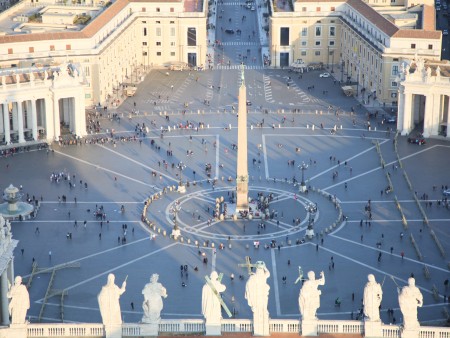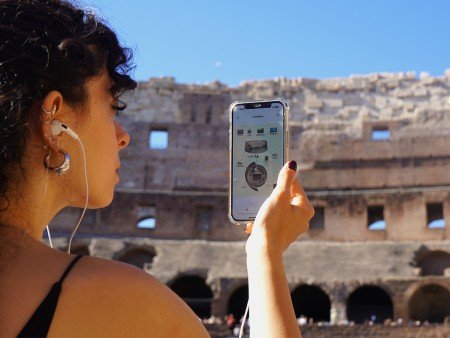The Spanish Steps: Baroque Charm in the Heart of Rome
The Spanish Steps in Rome, connect Piazza di Spagna with Trinità dei Monti church, find out its rich history and what to see nearby

20 December 2024
Rome Travel GuideThe Spanish Steps: A Timeless Icon of Rome
The Spanish Steps, or Scalinata di Trinità dei Monti, is one of Rome's most famous landmarks, attracting millions of visitors every year. Situated in the heart of the Eternal City, this magnificent stairway has been a meeting place, a cultural icon, and a source of inspiration for artists, writers, and travelers alike. Its history, architecture and significance combine to make it one of the most loved places in the world and a must-see for anyone coming to Rome. If you are looking for a guided tour to see the Spanish Steps and many other squares, as well as Rome's most iconic sites, in their original context, don't miss our Rome in Two Days Tour.
Why Is It Called the Spanish Steps?
The name "Spanish Steps" comes from the Piazza di Spagna (Spanish Square) at the base of the staircase. The square was named after the Spanish Embassy to the Holy See, which was located nearby during the 17th century. At the time, Spain held significant influence in Rome, and the area around the embassy became associated with the Spanish presence.
While the staircase itself was commissioned by a French diplomat, Etienne Gueffier, and connects Piazza di Spagna to the French church of Trinità dei Monti at the top, its popular name reflects the prominence of the square and Spain’s cultural legacy in the area. Over time, the name "Spanish Steps" became widely adopted, even though its origins are a blend of Spanish influence, French funding, and Italian craftsmanship.
A Brief History of the Spanish Steps
The Spanish Steps were constructed between 1723 and 1725 and were designed by the Italian architect Francesco de Sanctis. The project was funded by Etienne Gueffier, a French diplomat, as a way to connect the Piazza di Spagna (Spanish Square) at the base with the Trinità dei Monti church at the top. The stairway’s name, however, comes from the Spanish Embassy to the Holy See, which was located nearby and gave the square its name.
This ambitious architectural undertaking symbolized the connection between France (represented by the Trinità dei Monti church) and Spain (embodied in the square below), two influential European powers. It also served to beautify an important area of the city, enhancing Rome’s urban landscape.
The Spanish Steps are a masterpiece of Baroque architecture, blending elegance, symbolism, and practicality. The stairway is composed of 135 steps, arranged in an irregular yet harmonious pattern that creates a flowing, theatrical effect. Its design mirrors the natural topography of the slope, as the staircase widens and narrows in a dynamic and inviting way. Multiple terraces break up the climb, encouraging visitors to pause, admire the views, and enjoy the surroundings. At the top of the Spanish Steps stands the Trinità dei Monti church, a Gothic-style church with twin bell towers that dominate the skyline, while at the base lies the Fontana della Barcaccia (Fountain of the Old Boat), a Baroque fountain designed by Pietro Bernini, father of the famed Gian Lorenzo Bernini. The fountain’s boat-like shape is said to commemorate a flood of the Tiber River in the 16th century, when a boat was left stranded in the square.
The stairway’s gentle curves, terraces, and careful proportions embody the essence of Baroque architecture, transforming a steep slope into a monumental yet accessible connection between the square and the church.
The Barcaccia Fountain, a Bernini's work of art
The Fontana della Barcaccia at the foot of the Spanish Steps is a fascinating piece of Roman Baroque art. Commissioned by Pope Urban VIII in the early 17th century, the fountain was crafted by Pietro Bernini with assistance from his son, Gian Lorenzo Bernini. Its design is unique: shaped like a half-sunken boat, it is said to be inspired by the aftermath of a great flood in 1598 when a boat was left marooned in the square by the receding waters of the Tiber River.
The fountain’s low position is intentional, as the water pressure in this area was insufficient for a taller structure. The Barcaccia features decorative details such as sculpted suns and bees, symbols of the Barberini family, to which Pope Urban VIII belonged. The gently flowing water and artistic craftsmanship make the Barcaccia a tranquil and beautiful centerpiece of Piazza di Spagna.
What to See Nearby and other treasures of Rome
There is much to explore around the Spanish Steps, making it a perfect stop on a Roman itinerary:
-
Trinità dei Monti Church: Perched at the top of the steps, this French church dates back to the 16th century and houses impressive frescoes and artworks, including the Deposition by Daniele da Volterra, a pupil of Michelangelo.
-
Keats-Shelley House: Located to the right of the steps, this museum is dedicated to the Romantic poets John Keats and Percy Bysshe Shelley. It preserves artifacts, manuscripts, and memorabilia of the poets who found inspiration in Rome.
-
Via dei Condotti: One of Rome’s most famous shopping streets begins at Piazza di Spagna. Luxury boutiques and designer stores line this street, making it a paradise for fashion lovers.
Our categories:
You may also be interested ...

Vatican Private Tour with Sistine Chapel & St. Peter's Basilica: Renaissance’s Wonders
Private tour
Discover with a skip the line Private Vatican Tour the Sistine Chapel, Vatican Museums and St Peter’s Basilica
starting from: € 375

Colosseum Guided Audio Tour with Roman Forum and Palatine Hill
Private tour
Discover Ancient Rome’s secrets and history with our immersive Colosseum guided audio tour, rich in image and content
starting from: € 51 € 42